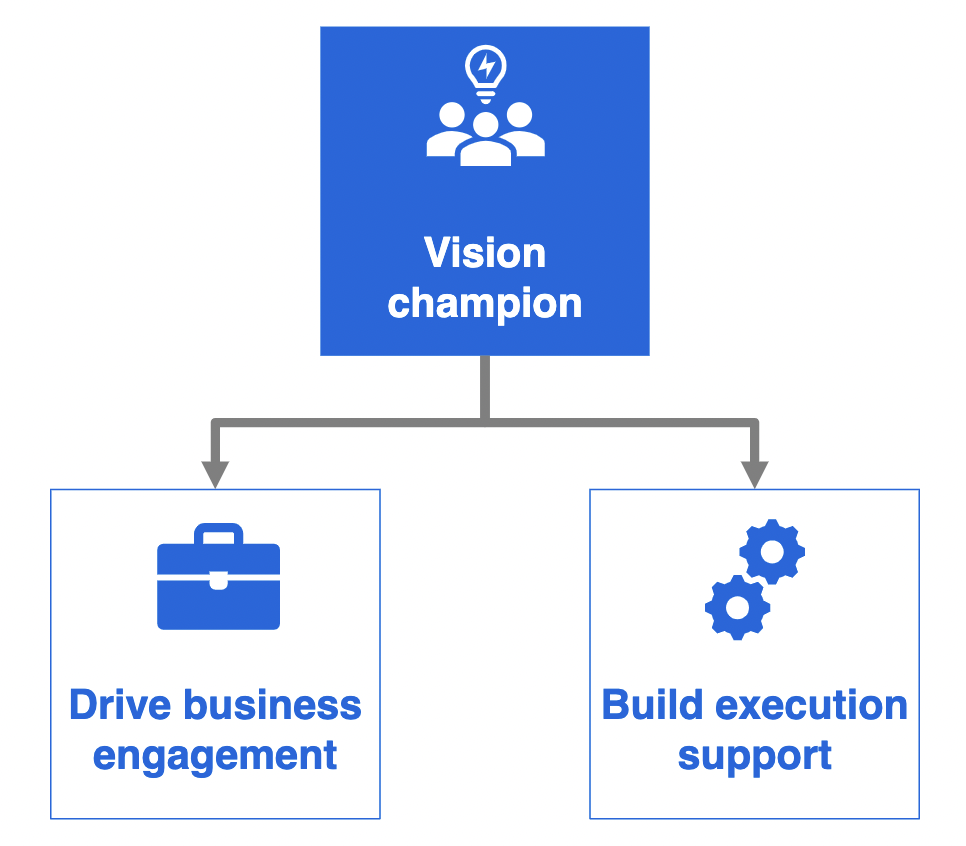Is Your Automation Program Ready For AI? Your AI Playbook (Part 1)
Share at:

Artificial intelligence (AI) extends the value of your automation program. Adding AI to your automation program opens up almost limitless opportunities to automate intelligent, cognitive processes—driving productivity, efficiency, and customer satisfaction to new heights.
During the AI Playbook webinar (part of our AI Summit), we turned to Brian Klochkoff, Head of Automation for Americas at dentsu international, to learn first-hand what it’s like to add AI to automation and attain this value. Whether automation for your business primarily refers to robotic process automation (RPA), data analytics, or machine learning (ML), incorporating AI into your automation program can make it more powerful and more comprehensive.
In this post, I’ll explain the two-step process that sets the stage for AI:
How to determine whether you’re ready to add AI to automation.
How to build momentum toward AI acceptance.
In part two of this series, I’ll show you how to integrate AI models into your existing automation program and which best practices to follow.
Determine whether you're ready to add AI to your automation program
Enterprises examining AI technologies are right to ask whether or not they’re ready. We’ve boiled this complex problem down to two questions.
1. Do you have a vision champion?
A vision champion is a leader who drives business engagement and execution support.
In our post on building a team to support an automation operating model, we define two types of executive sponsors: the mobilizer and the digital steward. The mobilizer explains the value of automation, recruits talent to the RPA team, and attracts initial funding. The digital steward takes what the mobilizer established and builds on top of it by convincing executives to buy in and steering the automation team to its next stage of growth.

A vision champion requires a mix of these skills. When you’re layering AI on top of automation, you may already have a mobilizer, a digital steward, and (hopefully) many other fans of automation. What you need from an AI vision champion is different.
When examining someone who could be your AI vision champion, ask yourself these questions:
Will this person be passionate and relentless in championing the AI vision? Proponents of AI, even when talking to people who use automation, may face skepticism and your vision champion can’t be someone who is easily dismayed.
Does this person have a strong influence on the organization and executive stakeholders? Passion and determination will only go so far—a great vision champion needs to have the influence to match their drive. The strategy must be enterprise wide, so this person’s influence must be too.
Can this person articulate a strong business case to executive stakeholders? Finally, this person must be able to articulate the benefits of AI in a way that executive stakeholders will understand and believe.
The answers to the above questions will help you determine the answer to the larger question: Do you have a vision champion?

Once you have a champion in mind, we can move on to the next major question.
2. Is your automation program mature enough for AI?
In previous articles, we’ve compared automation to a journey and provided frameworks for scaling. We emphasize the long-term nature of automation because of its potential for top-to-bottom transformation. That level of change requires a long-term perspective.
Which is why it’s so important to be critical about whether it’s the right time to add AI to your automation program. We believe all businesses will eventually consider AI essential, but that doesn’t mean all businesses should rush to implement AI today.
To determine the maturity of your automation program, ask yourself and your team these questions:
Do you have existing governance and processes in place for an automation program? Deploying AI into an automation program without existing governance can diminish the impact of AI, worsening its business case. Plus, a lack of governance can make people wary of the risks new technologies sometimes pose. Start by adding governance to your existing automation program. With governance in place, you can layer new solutions, like AI, on top, and give your team confidence and peace of mind.
Do you have existing infrastructure and resources to leverage? Complex AI implementations need data scientists as well as RPA developers. The skill sets of your data scientists and RPA developers are complementary, but they may not know how to work together yet. With the right governance structure, you can configure new workflows that enable these teams to collaborate.
Do you have a vision for democratizing AI for business users? Democratization empowers business users to use automation and AI. Build your vision for democratization into your AI rollout. This vision ensures the design of AI infrastructure and governance that has business users in mind.
A mature automation program, in Klochkoff’s words, will involve resources who are “passionate about finding the intersection of operational excellence and technological potential.” That intersection is essential because a passion for AI and ML is necessary, but not sufficient, for success. Business practicality is important, too.
Automation program maturity isn’t something you just have to wait around for. By building an automation operating model, you can move through the early stages of automation implementation and scale automation effectively.
Build momentum toward AI excitement
AI is on the agenda of every C-suite executive, but so are many other competing initiatives. To get the C-suite, as well as your company, excited about AI, focus on building momentum by demystifying, engaging, and demonstrating the case for investing in AI.
Demystify AI to ally fears and stir excitement
AI is still frequently misunderstood, partially because of how many different technologies there are out there. There’s now a spectrum of tools ranging from the simple—accessible to business users—to the complex, accessible primarily to data scientists.
Even if your company has a thriving automation program full of engaged leaders, it doesn’t mean anyone understands AI. That lack of understanding can lead to wariness, if not outright fear. Your goal is to make AI a realistic, understandable entity––one that people from the executive level on down can understand.
“At the end of the day,” Klochkoff says, “I think that automation is something that’s actually human, for a lot of us ... If you’re removing that high-volume, tedious, monotonous work, no matter which way, anyone from a CFO to an entry-level assistant can identify with that.”
We recommend three ways to demystify AI:
Make human connections: find stakeholders who understand that, in Klochkoff’s words, “incremental progress is more important than perfection.” AI, due to the nature of ML and AI models, will rarely be perfect the first time. Help people understand that the goal is to reach a confidence threshold and teach the models over time.
Identify the right business case: Klochkoff says you need to “bridge the mental gap” between idea and implementation by showing stakeholders the ways AI will affect their daily lives. AI often feels scary because it’s distant, so do your best to make it feel real, instead of abstract. The right business case will be a proof of concept and, once implemented, demonstrate proof of value.
Focus on proof of value: showcase the potential of AI with simpler technologies. Klochkoff recommends using a familiar technology, like Amazon Alexa. Alexa is far away from enterprise AI, but your audience’s familiarity with it helps them understand its value. If you can show them how a voice assistant can add value via AI, you’re one step closer to proving the value of enterprise AI.
Klochkoff recommends you ask your stakeholders to imagine a “voice assistant for business.” How can we give people access to IT self service with natural language processing (NLP), for example? Explain the benefits such an implementation might have. Use the analogy to show that even an imperfect implementation is useful, too. Millions of people use an Alexa, even though it doesn’t understand their queries 100% correctly every time.
These aren’t three separate methods, but three components to a good case for AI.
Engage leaders, employees, and resources in the solutions AI offers
As you build momentum, keep in mind that different stakeholders compose your audience, meaning that your messaging needs to shift depending on who you’re talking to.
When you talk to leaders, appeal to them by showing how RPA and AI can help solve real business problems. Business problems are the language they speak, so speak the same language to them.
When you talk to employees, walk them through use cases. Show employees how they will be able to integrate AI into their everyday work. Again, demystify. As much as necessary, take the time to explain some of the AI logic they’ll be interacting with. They’ll still, ultimately, be responsible for the results of these processes.
When you’re talking to resources more broadly, focus on breaking down silos. Your goal is to enable different departments to work together, especially your RPA center of excellence (CoE) and your data analytics CoE. This won’t always be easy.
As you move further along the spectrum toward technical development skills, Klochkoff warns, you might encounter a stigma around RPA. RPA, to some, feels out of date. Educate them otherwise. With platforms like UiPath AI Center, you can do much more than was previously possible. “When the business value is there,” Klochkoff says, so is a research and development (R&D) budget, meaning your highly technical employees will get a 'broad sandbox' to play in."
As you build engagement, you’ll be able to show, at all levels, how you can weave AI into an existing RPA solution. The support of leaders, employees, and resources is necessary for an elegant implementation.
Seek out people who really understand AI
If you take away one lesson from this article, make it this: focus on results. You can have all the demos and examples in the world, but nothing speaks volumes like use cases with results.
Find use cases early on and find the right audience to demonstrate them to. The right use case will demonstrate progress and real-world effects.
The solutions which fail are the ones that don't have stakeholders actively engaged throughout the lifecycle. If the project team is only interested in the initial results and not optimizing those results over time, it's going to be an uphill battle to show value.
Brian Klochkoff, Head of Automation, Americas, Dentsu International
Take this example of ApprioHealth, which used UiPath AI Computer Vision to process high volumes of medical insurance claims quickly and efficiently. The team at ApprioHealth were experienced users of RPA but they found that their virtual desktop infrastructure (VDI) hindered its effectiveness. With AI Computer Vision, software robots can see computer screens just as humans would, meaning ApprioHealth could use RPA across any VDI system.
This use case was ideal because the team understood the progress that was possible and when they pursued it, RPA efficiency increased by seven times.
The right audience will also be knowledgeable enough to know technical concepts, the business value of AI, and why their engagement in an AI initiative is critical.
This is where demonstration can sometimes go wrong. Klochkoff experienced this on one occasion working with front-office stakeholders who lacked a certain level of technical acumen. His team built an AI solution that could pre-generate responses to client proposals.
“People were really excited to work on such an interesting and complex problem that would bring value to them, but when the solution wasn’t delivering at a confidence threshold of 100%, they didn’t really care,” Klochkoff said. Stakeholders who had once been excited became apathetic once they saw that threshold. They cared about the small portions of questions they knew the answer to that the AI solution didn’t. This wasn’t an ideal group to start with, Klochkoff admitted.
Everyone likes to participate in what Klochkoff called “buzzword bingo” (which can include AI, ML, and RPA), but for some projects you have to seek people who really understand the technologies at hand. Klochkoff had the most success with “people they’ve worked with for years.”
During one project, they went from 76% accuracy to 97% accuracy over the course of four to six weeks, “and that wouldn’t have been able to happen without the ongoing engagement and participation from our friends in the technology function.”
Mutual understanding is what will grant you the ability to deploy solutions beyond proof of concept and eventually scale.
Leverage your momentum and execute
Though leading businesses will all eventually have to learn how to use AI to be competitive, a mistimed implementation can be as risky as a missed implementation. Don’t delay, but also don’t rush.
We’ve discussed how to test for readiness and build momentum; in part two, we’ll explain just what to do with that momentum. Once you have excitement on your side, the integration of AI models into your automation program is within your sights.
To hear Brian Klochkoff and me in our own words, check out the recording of the AI Playbook webinar.
Topics:
Artificial Intelligence (AI)
Managing Director, Intelligent Automation, Huron
Get articles from automation experts in your inbox
SubscribeGet articles from automation experts in your inbox
Sign up today and we'll email you the newest articles every week.
Thank you for subscribing!
Thank you for subscribing! Each week, we'll send the best automation blog posts straight to your inbox.



